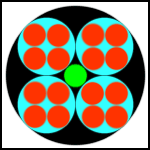
Begin with one
BLACK circle, and inscribe 4 identical, interior, cyclically tangent,
CYAN circles, such that they are also tangent to the black circle.
In each of the four cyan circles, inscribe 4 RED interior circles in exactly the same way.
Finally, inscribe a small GREEN circle in the center of the original black circle, tangent to the cyan circles.
Which is larger, this small green circle, or one of the small red circles?
Draw a line from the center of the green circle (which by symmetry is the center of the black circle) up and to the left to the edge of the black circle, where a cyan and a red circle are tangent to the black circle. Do the same, but this time to the lower left. Connect the two points on the edge of the black circle with a straight line segment. The resulting triangle is, by symmetry, an isosceles right triangle with the right angle at the center of the green/center of the black circle. We are going to make a couple of vertical lines to make smaller isosceles right triangles incorporating the same right angle.
Let the radius of a cyan circle be 1.
Draw a line between the center of the upper left cyan circle and the center of the lower left cyan circle. These are points on the triangle you drew before. The line creates another, smaller, isosceles right triangle that is part of the larger.
Finally draw a line from the point of tangency of the upper-left cyan circle and the green circle to the point of tangency of the lower-left cyan circle and the green circle. This forms a still smaller triangle within the larger, similar, triangle.
You've formed three isosceles rt triangles-- nested, sharing portions of their legs, with a common point at their common right angle in the center of the whole figure. The middle-size triangle's hypotenuse has length 2, as it is two cyan radii. So the leg measured out from the center (the rt angle) to the center of either cyan circle is sqrt(2). That makes the radius of the green circle sqrt(2)-1, as the rest of that leg of the middle-size triangle is a radius of the cyan circle, of length 1.
The radius of the black circle is just the opposite, that is sqrt(2)+1, as the largest triangle you've formed has a leg that's larger than that of the middle-sized one by one cyan-circle radius, or 1.
So the cyan circles are 1/(sqrt(2)+1) the radius of the black circle. Since the red circles fit within the cyan circles the same way as the cyan circles fit within the black circle, the red circles are 1/(sqrt(2)+1) the radius of a cyan circle. But the latter has been assigned the length 1, so the red circles have radius 1/(sqrt(2)+1).
But the radius of the green circle is sqrt(2)-1. This is equal to 1/(sqrt(2)+1). So the green and red circles are equal in size.
Edited on June 16, 2004, 2:45 pm
|
|
Posted by Charlie
on 2004-06-16 14:43:48 |
 Begin with one BLACK circle, and inscribe 4 identical, interior, cyclically tangent, CYAN circles, such that they are also tangent to the black circle.
Begin with one BLACK circle, and inscribe 4 identical, interior, cyclically tangent, CYAN circles, such that they are also tangent to the black circle.


